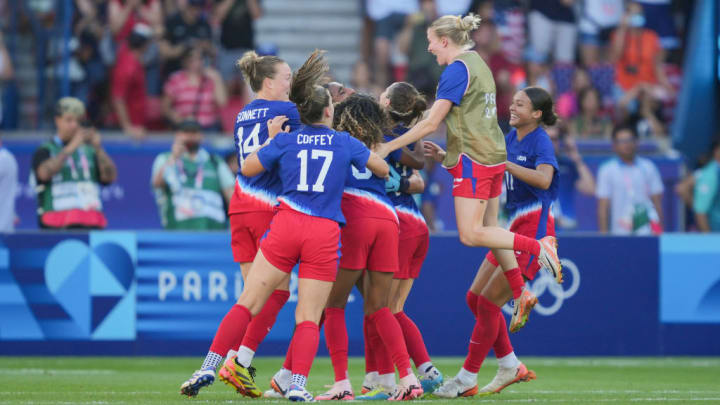Relentless USWNT Caps Off Gritty Olympics Run With First Gold Medal Since 2012

The U.S. women’s national team dropped into an exhausted and joyous heap on the pitch of Parc des Princes, tears flowing after defeating Brazil 1–0 to claim its first gold medal since 2012. Coach Emma Hayes warned that Saturday’s Olympic final wouldn’t be pretty. And ugly it was, with the USWNT gutting out a victory behind a brilliant goal from Mallory Swanson. Contending with heavy legs, bogged down by six games in 16 days and a limited rotation, the U.S. had to dig deep against an energized, Marta-led Brazilian side. For Hayes, overcoming fatigue—and all that comes with it—was all part of the plan.
“I want them to suffer,” Hayes said ahead of the gold-medal match. “I want them to have that moment because I do not believe you can win without it.”
Employing videos of ultramarathoner Courtney Dauwalter to inspire her core, which she relied on with little substitution, Hayes encouraged her team to look pain in the face and overpower it. Winning amid struggle has long been a critical part of the USWNT’s ethos, and now Hayes has instilled a similar dogged mindset in the next generation.
“That U.S. mentality, it’s in us it’s kind of like can we reach back in and really bring it out,” Captain Lindsey Horan said ahead of the final, referencing the iconic U.S. 99ers team.
There was a real sense that the USWNT simply refused to lose this gold-medal match—a stubbornness best exemplified by the heroics of veteran goalkeeper Alyssa Naeher. She made several impressive saves to maintain a clean sheet, the most astounding of which came in stoppage time. Naeher denied Brazil a close-range header, stretching to paw away what would have been a last-minute equalizer.
ALYSSA NAEHER TO THE RESCUE. AN UNBELIEVABLE SAVE IN STOPPAGE TIME. 😱#ParisOlympics | 📺 NBC and Peacock pic.twitter.com/fsJoNKSI40
— NBC Olympics & Paralympics (@NBCOlympics) August 10, 2024
Hayes will and should be applauded for cultivating a winning mindset in only 10 games at the helm of the U.S. team. But for all the talk of winning ugly, the beauty of the front three should not go unnoticed. Amid low blocks, mid blocks, slogs and unrelenting opponents, Trinity Rodman, Sophia Smith and Swanson continuously found ways to break through.
On Saturday, in Paris, it was Swanson’s turn. After a treacherous opening half, the USWNT returned from the locker room with renewed focus as the forwards began to click. A dangerous chance finally came in the 57th minute, with Swanson streaking in behind the Brazilian back line, getting on the end of a well-weighted pass from midfielder Korbin Albert, before charging into the box and slotting a low shot into the back of the net. Swanson’s clinical go-ahead finish proved to be the decider, stifling any remaining Brazil momentum.
TEAM USA STRIKES FIRST—AND IT'S MALLORY SWANSON AGAIN!
— NBC Olympics & Paralympics (@NBCOlympics) August 10, 2024
1-0 IN THE GOLD MEDAL MATCH.#ParisOlympics | 📺 NBC and Peacock pic.twitter.com/rCEQNIbR68
It was a full-circle moment for the 26-year-old, who logged her 100th USWNT cap in the Olympic final. Swanson first joined the U.S. team as a teenage phenom, representing the U.S. in Rio in 2016. In the years to come, however, Swanson would face injury trouble, complicating her much-anticipated ascent to the top of U.S. women’s soccer. A fixture of the USWNT in its lead-up to the 2023 World Cup, Swanson was playing some of the best football of her career before tragically tearing her left patella tendon in April. After missing last year’s world championship in Australia, Swanson got a shot at redemption in Paris—much to the U.S.’s benefit.
“She’s such an incredible player, teammate,” Smith said. “I think she just brings the energy to this team that we have been missing. Mal, I mean, is a huge piece for us.”
There were instances of individual brilliance scattered across the pitch for the U.S., showing up at different times throughout the Games. Naomi Girma staked her claim as the best center back in the world, rarely putting a foot wrong. Fellow defenders Crystal Dunn, Tierna Davidson and Emily Fox should be lauded, too, only letting in two goals in the tournament’s six games.
Those distinct pieces of the USWNT, while dazzling, weren’t always in step, and the tactics weren’t always executed to precision, but still, an apparent sense of unity coated the group. In just three months, Hayes curated a new persona for the U.S., sweeping away the haunting memories from a dreadful World Cup.
“It’s been noted on more than one occasion what happened at last year’s World Cup,” Hayes said, “but for us, our whole focus has been on creating our own identity.”
With a gold medal around their necks, Hayes & Co. has certainly formed a new, but familiar identity: one of winners. Standing atop the podium in Paris, the USWNT is miraculously back on top of the world for the first time since 2019. And just like that, as quickly as it started, a new USWNT era is officially in full swing.
